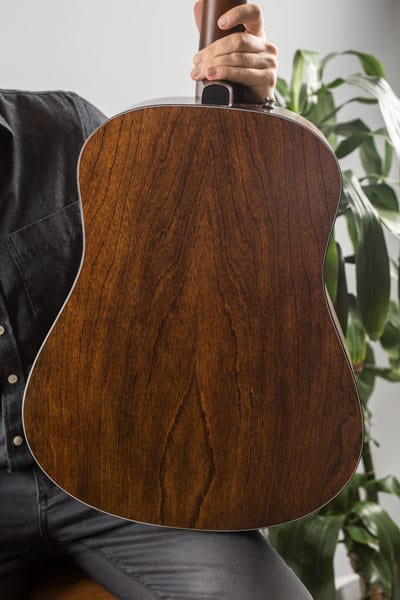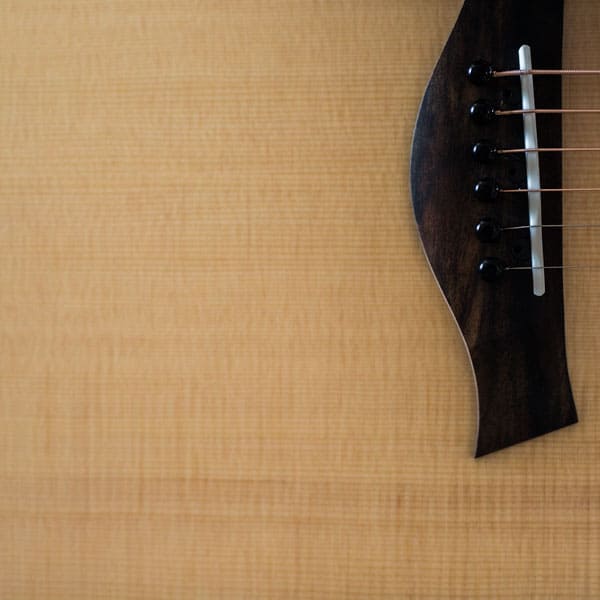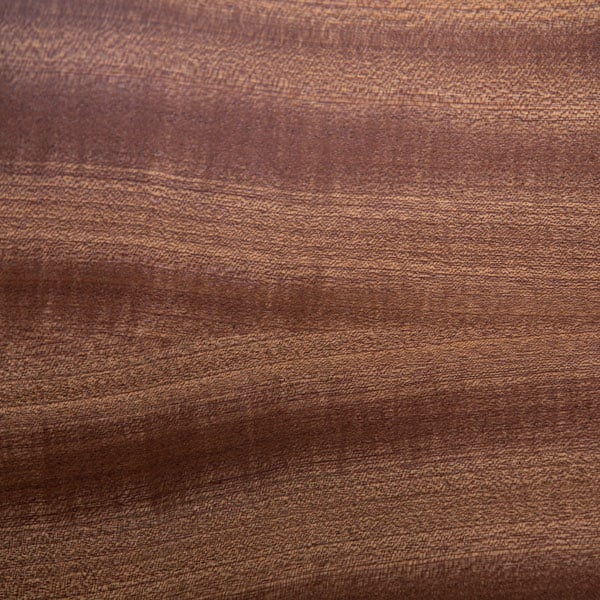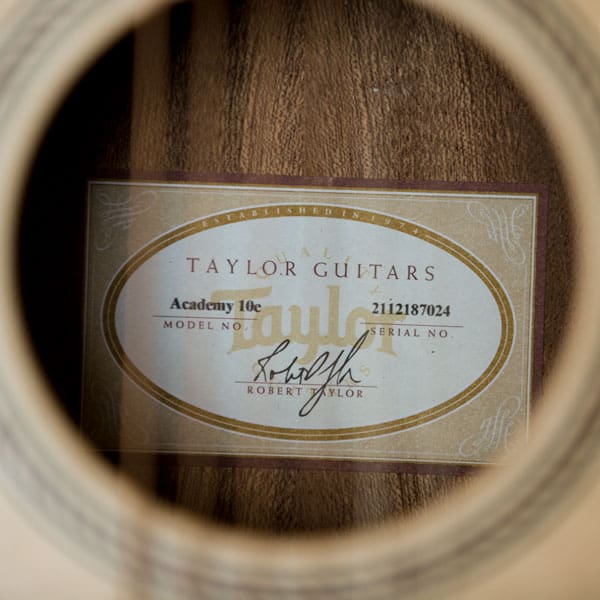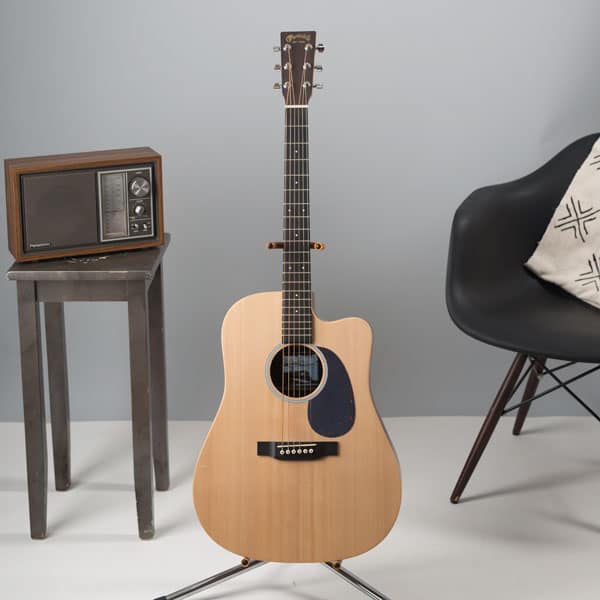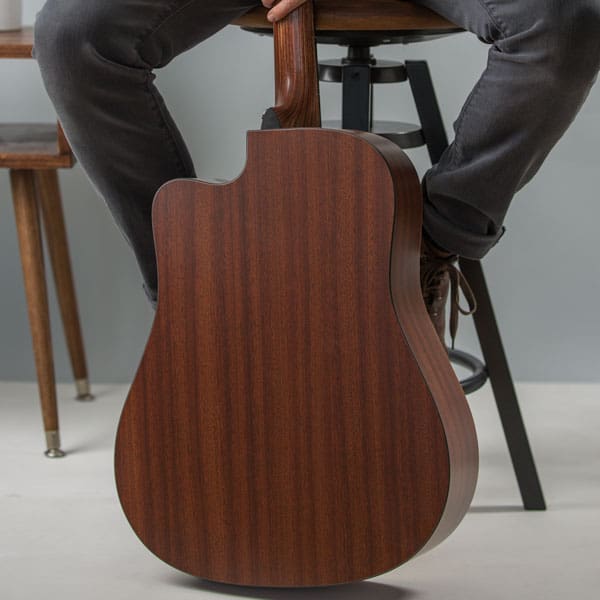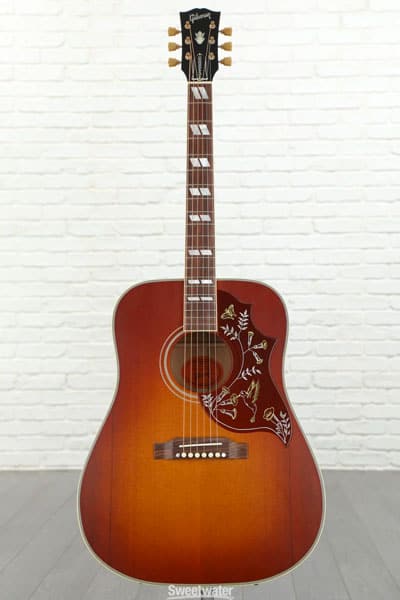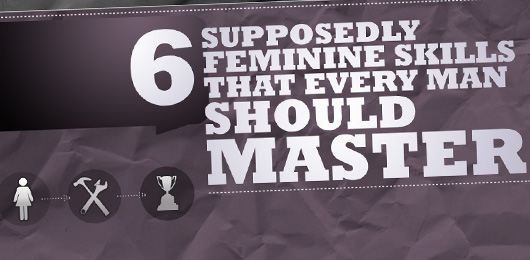Yeah, I played a little “college guitar.”
Twelve bar blues, Radiohead, Dave Matthews, and some classic rock. I picked up guitar in high school, jammed in undergrad, and never really learned more than I needed to strum some college party favorites.
Acoustic guitar was the perfect instrument for me because I could grab it and, without needing any special training, gear, or fancy musical knowledge make a great sound with a handful of simple chords.
Guitar is also a social instrument. I wasn’t shredding at open mics but I had a regular jam sesh with my buddies and it was a blast.
Perhaps the most notable thing about me as a guitarist was my instrument, which far surpassed me in terms of its quality: a C.F. Martin & Co. D-16 with rosewood back and sides and a solid spruce top (more on why that’s important in a moment).
Why should you care what guitar I had? One simple reason: owning a quality instrument makes a huge difference in the pleasure you experience making music.
Sound quality, playability, and longevity skyrocket when you transition from your first plywood or cardboard thrasher to a real wood guitar. I know that’s what happened for me.
So whether you’ve been playing for years and are ready to upgrade, or are interested in taking up the guitar but don’t feel like spending a hundred bucks on something you’ll outgrow in a month, check out our Budget / Basic / Broke guide to your next acoustic guitar.
What To Look For In A “Real” Guitar
I mowed lawns for a hot Illinois summer to buy my D-16 at the local guitar shop.
Looking back, I realize I got lucky – the guys there steered me towards one of the great American guitar brands, crafted out of some of the best materials you can find for a quality and, at the time, entry-level premium flat-top.
But that was nearly twenty years ago, and I’m no expert.
So we’ve enlisted the help of master luthier, banjo builder, and legendary Nashville musician Marty Lanham. He’s built guitars and banjos for the likes of Johnny Cash, Bela Fleck, Chet Atkins, Earl Scruggs, Marty Stuart, and Steve Martin.
He’s gigged at the Grand Ole Opry, and when the Country Music Hall of Fame needed some priceless guitars restored, they called Marty. His latest venture is teaching regular folks how to build their own guitars at Nashville’s Guitar Craft Academy.
I asked Marty to break down the must-have qualities of a lifetime guitar.
1. Tone
“Number one would be tone,” says Marty. “An acoustic guitar is its own tone maker and you really need to like the sound of it.”
Of course, tone is pretty subjective. What sounds bright and brassy to one ear might sound muddy and lack precision to someone else. As Marty tells it, you simply have to listen to a bunch of guitars.
“Shopping is really important,” he says. “If you can go to a store and play a variety of guitars you’ll start to educate your ear. Tone is fairly subtle and everyone has different tastes.”
It’s impossible to talk about tone, however, without understanding the massive importance of what’s making that tone…
2. Wood
When you step up to your first lifetime guitar, you’re really talking about two things – build quality and the once-living material guitars are crafted from: solid wood.
“I’ve been collecting wood for over 50 years,” says Marty. “Yard sales, mill closings, anywhere. I’ve got a whole inventory of exotic wood I’ve been saving under the category of ‘someday I’ll build something from this.’”
Marty’s compares his focus on quality wood to a chef: the best food necessarily begins with the finest ingredients. Guitars are no different.
Entry-level, mass-produced guitars are made from inexpensive, mass-produced materials and their tone quality suffers as a result. To save money, the back and sides of many guitars are made from laminate – layers of wood glued together – instead of solid wood.
These woods are referred to as “tone woods,” because of their resonant qualities and suitability to guitar building.
According to Marty, 80% of the guitar’s tone comes from the top, where the hole is placed, known as the soundboard. “The wood has to be light and stiff – stiff to withstand the 180 pounds per square inch pull of the strings, and light enough to vibrate,” he says.
So what tone wood should you look for?
Spruce is the primary wood used for soundboards. Within the spruce category, sitka is a popular subspecies. “The most popular right now is eastern red or Adirondak spruce,” advises Marty. “German or Bavarian spruce are also popular.” Western cedar and redwood are also excellent.
Woods like rosewood, koa, and walnut are often used for the rest of the guitar, and be warned – whole tone woods are pricey!
 3. Playability
3. Playability
The first time I visited a guitar shop and played something other than my $50 starter guitar, I was amazed – by the sound and also how easy it was to play a quality guitar.
I wasn’t magically a better musician. I just didn’t have to bear down on the strings like I was trying to choke the guitar to death.
“Perhaps the most important and most overlooked quality of a guitar is playability,” says Marty, referring to the left hand set up – how far the strings sit over the fretboard, and the quality of the playing surface.
“The playing surface is where your first encounter with pain comes in. It’s difficult to press down until you build callouses, and a properly set up guitar can encourage one to practice and play.”
If you’re not sure about evaluating a new guitar’s playability, bring a friend. “It would be good to have someone – a teacher or accomplished friend – go along for shopping to give advice for how well a guitar might play,” advises Marty.
4. Size
The size and cut of your guitar doesn’t really relate to quality, but it’s an important consideration nonetheless.
“Size is an important thing to consider,” says Marty. “Ask yourself: what job do you want to do with your instrument? Are you playing in church, with a combo, by yourself? Consider the volume of the guitar.”
There’s a range of size options available, but for the majority of casual players the choice is between three options: Dreadnought, Classical, and, well, what we’ll call In Between.
The Dreadnought is what I chose (The D in Martin D-16 stands for Dreadnought) because of it’s big, boomy sound that played well on outdoor decks and filled dorm rooms with sound. As Marty put it, “Dreadnoughts push a lot of air through the soundhole,” due to their size.
The next most common guitar size is the Classical. These are smaller and typically accept nylon strings. Classical guitars are often given to kids as starter guitars because the strings are more gentle on the hands, but they have a tone all their own and are extremely pleasing to play.
That brings us to everything that falls between Dreadnoughts and Classical guitars, often referred to as “auditorium” size. Each manufacturer has their incredibly complex name and number conventions, and the best option is to go and try a variety of shapes and sizes to find one that fits your volume and ergonomic needs.
5. Electronics
Many acoustics now come with built-in pickups and volume controls so you’re ready to plug into an amp and jam with a band or at an open mic. This is strictly down to preference and application – pickups don’t affect the unplugged sound quality of the guitar much (if at all), but they’re nice to have in case you want to room to grow out of bedroom jamming.
6. Budget
Marty’s common sense advice for how much to spend? “Spend a bit more and you stand a better chance of getting money out of the piece later.”
In 2000 I spent about $800 on my Martin D-16 RGT and today it’s re-selling for about $1300. That’s not stock market-level appreciation, but for an everyday guitar it’s not bad.
“My line is: over 500 you tend to start looking at American made pieces of better quality,” he says.
The good news is, for $500 and above you can get a lot of guitar. So check out our recommendations below, curated with help from Marty and guitar journalist Glen Parry of Audio Mastered.

Seagull S6 Acoustic Guitar, $419 with hardshell case and stand
Budget: Seagull S6
Seagull is a well-regarded Canadian company that’s been hand-building guitars out of Quebec since the 80s.
The S6 features a solid cedar top, wild cherry back and sides, and a rosewood fingerboard and bridge – tone-rich woods for the price. No wonder it’s the company’s #1 seller.
I have an S6 in the family (purchased for my bluegrass-loving mother) and really enjoy its easy-playing mechanics when I’m at home. Seagulls have a ringing, treble-rich quality that I find pleasing. The S6 lacks a bit, however, on the low-end bass tones.
Our Budget Buy: S6 Acoustic Guitar, $419
Basic: Taylor 110e Dreadnought & Martin DCX1AE
When it comes to American guitar brands there are two giants, each with their relative strengths and weaknesses (and rabidly devoted tribes): Taylor and Martin.
To avoid the (inevitable) threats to body and property from each tribe’s adherents, we’re recommending a guitar from both. First, the Taylor:
Says journo Glen Parry, “The 110e is perfect for those who aren't yet tied down to a specific genre or playing style. The dreadnought body style gives a lot of projection and the solid Sitka spruce top produces a nice bright tone.”
It’s also worth taking a peek at the layered Sapele wood back:
An added feature are the included pickups. “Taylor's ES2 electronics are great for anyone who may potentially see themselves needing to plug in onstage,” says Glen Parry, noting the electronics are unique to Taylor.
Next up is the Martin DCX1AE:
Like Taylor, Martin is a legendary company in acoustic guitar circles, and with good reason: they build quality lifetime guitars that sound great. The DCX1AE has a solid Sitka spruce top and comes with a cutout shape for enhanced upper-neck shredding or fingerwork for a slightly different look than the Taylor.
Tonewise, Glen Parry notes, “It has the same specs as the Taylor and is going to sound very similar.”
One drawback to both the Martin and Taylor is that the back and sides aren’t solid wood. Taylor refers to the Sapelle as “layered,” and Martin as “laminate with Mahogany pattern.” But with these brands at this price point, it’s hard to do better.
Our Basic Buy: Taylor 110e Dreadnought, $749 & Martin DCX1AE, $699
Broke: Premium, Custom, or Vintage?
If you’re looking seriously in the Broke category you probably don’t need us to tell you about quality guitars.
We hesitate to just recommend a guitar in the $1000 – $2000 range because it will be arbitrary. Your options above $1000 simply explode and the choice becomes about application, personal preference, and ergonomics.
That said, it’s ok to dream, right?
Personally, I’d pick up a Martin GP-35E, but I’m a bit of a Martin fanboy. Glen Parry’s ultimate dreadnaught?
Premium: Taylor 910e, $4,899
The 910e is Taylor’s premium dreadnaught, with the finest tonewoods and gorgeous details like ebony binding, koa purfling, mother-of-pearl inlay. And it sounds good, too.
Marty Lanham’s suggestion? Consider shopping vintage. As hardwoods become harder (and less environmentally sustainable) to secure, vintage guitars can offer a one-of-a-kind sound and bygone build quality.
One option is to find a well-cared-for specimen of one of the most iconic guitars ever:
Vintage: Gibson Hummingbird circa 1960s
There’s no link above because you’ll need to hunt for this classic guitar in all it’s sunburst finished glory at guitar shops and online, being wary of fakes. If you don’t have the patience, the 2016 model from Gibson is highly regarded:
Gibson Hummingbird 2016, $5,000
Finally, you can take the plunge and go custom. Marty Lanham’s Nashville Guitar Company will undoubtedly build you something special, and Glen Parry recommends Maine’s Dana Bourgeois.





 3. Playability
3. Playability

